Inter-Regulation of Kv4.3 and Voltage-Gated Sodium Channels Underlies Predisposition to Cardiac and Neuronal Channelopathies
Abstract
:1. Introduction
2. Results
2.1. R878C, G1743R and E555X Nav1.5 Variants Affect Ito
2.2. LOF and GOF Variants of Kv4.3 Alter INa from Nav1.5 and Nav1.1
2.3. Beta-Subunits of the Megacomplex Regulate the Balance between INa and Ito
2.4. Nav1.5 and Kv4.3 Are Able to Interact
3. Discussion
4. Methods
4.1. cDNA Cloning and Mutagenesis
4.2. HEK293 Cell Culture and Transfection
4.3. Solutions for Electrophysiological Recordings
4.4. Electrophysiological Recordings
4.5. Co-Immunoprecipitation
4.6. Duolink
4.7. Cell Surface Biotinylation
4.8. Statistical Analysis
Supplementary Materials
Author Contributions
Funding
Acknowledgments
Conflicts of Interest
Abbreviations
| AP | Action Potential |
| BrS | Brugada syndrome |
| Nav | Sodium voltage-gated channels |
| INa | Inward sodium current |
| WT | Wild type |
| ER | Endoplasmic reticulum |
| Ito= IA | Transient outward potassium current |
| SCA19/22 | Spinocerebellar Ataxia type 19 and 22 |
| LOF | Loss of function |
| GOF | Gain of function |
References
- Antzelevitch, C.; Yan, G.-X.; Ackerman, M.J.; Borggrefe, M.; Corrado, D.; Guo, J.; Gussak, I.; Hasdemir, C.; Horie, M.; Huikuri, H.; et al. J-Wave syndromes expert consensus conference report: Emerging concepts and gaps in knowledge. J. Arrhythmia 2016, 32, 315–339. [Google Scholar] [CrossRef] [PubMed]
- Clatot, J.; Ziyadeh-Isleem, A.; Maugenre, S.; Denjoy, I.; Liu, H.; Dilanian, G.; Hatem, S.N.; Deschênes, I.; Coulombe, A.; Guicheney, P.; et al. Dominant-negative effect of SCN5A N-terminal mutations through the interaction of Nav1.5 α-subunits. Cardiovasc. Res. 2012, 96, 53–63. [Google Scholar] [CrossRef] [PubMed] [Green Version]
- Giudicessi, J.R.; Ye, D.; Tester, D.J.; Crotti, L.; Mugione, A.; Nesterenko, V.V.; Albertson, R.M.; Antzelevitch, C.; Schwartz, P.J.; Ackerman, M.J. Transient outward current (Ito) gain-of-function mutations in the KCND3-encoded Kv4.3 potassium channel and Brugada syndrome. Heart Rhythm 2011, 8, 1024–1032. [Google Scholar] [CrossRef] [Green Version]
- Portero, V.; Wilders, R.; Casini, S.; Charpentier, F.; Verkerk, A.O.; Remme, C.A. KV4.3 Expression Modulates NaV1.5 Sodium Current. Front. Physiol. 2018, 9, 178. [Google Scholar] [CrossRef] [PubMed]
- Duarri, A.; Nibbeling, E.; Fokkens, M.R.; Meijer, M.; Boddeke, E.; Lagrange, E.; Stevanin, G.; Brice, A.; Durr, A.; Verbeek, D.S. The L450F [Corrected] mutation in KCND3 brings spinocerebellar ataxia and Brugada syndrome closer together. Neurogenetics 2013, 14, 257–258. [Google Scholar] [CrossRef]
- Grant, A.O.; Carboni, M.P.; Neplioueva, V.; Starmer, C.F.; Memmi, M.; Napolitano, C.; Priori, S. Long QT syndrome, Brugada syndrome, and conduction system disease are linked to a single sodium channel mutation. J. Clin. Invest. 2002, 110, 1201–1209. [Google Scholar] [CrossRef]
- Lee, Y.-C.; Durr, A.; Majczenko, K.; Huang, Y.-H.; Liu, Y.-C.; Lien, C.-C.; Tsai, P.-C.; Ichikawa, Y.; Goto, J.; Monin, M.-L.; et al. Mutations in KCND3 cause spinocerebellar ataxia type 22. Ann. Neurol. 2012, 72, 859–869. [Google Scholar] [CrossRef] [Green Version]
- Valdivia, C. A trafficking defective, Brugada syndrome-causing SCN5A mutation rescued by drugs. Cardiovasc. Res. 2004, 62, 53–62. [Google Scholar] [CrossRef]
- Zhang, Y.; Wang, T.; Ma, A.; Zhou, X.; Gui, J.; Wan, H.; Shi, R.; Huang, C.; Grace, A.A.; Huang, C.L.-H.; et al. Correlations between clinical and physiological consequences of the novel mutation R878C in a highly conserved pore residue in the cardiac Na+ channel. Acta Physiol. 2008, 194, 311–323. [Google Scholar] [CrossRef] [Green Version]
- Clatot, J.; Zheng, Y.; Girardeau, A.; Liu, H.; Laurita, K.R.; Marionneau, C.; Deschênes, I. Mutant voltage-gated Na+ channels can exert a dominant negative effect through coupled gating. Am. J. Physiol. Heart Circ. Physiol. 2018, 315, H1250–H1257. [Google Scholar] [CrossRef] [PubMed]
- Clatot, J.; Hoshi, M.; Wan, X.; Liu, H.; Jain, A.; Shinlapawittayatorn, K.; Marionneau, C.; Ficker, E.; Ha, T.; Deschênes, I. Voltage-gated sodium channels assemble and gate as dimers. Nat. Commun. 2017, 8, 2077. [Google Scholar] [CrossRef] [Green Version]
- Antzelevitch, C.; Patocskai, B. Brugada Syndrome: Clinical, Genetic, Molecular, Cellular, and Ionic Aspects. Curr. Probl. Cardiol. 2016, 41, 7–57. [Google Scholar] [CrossRef] [PubMed] [Green Version]
- Antzelevitch, C.; Yan, G.-X. J-wave syndromes: Brugada and early repolarization syndromes. Heart Rhythm 2015, 12, 1852–1866. [Google Scholar] [CrossRef] [PubMed] [Green Version]
- Di Diego, J.M.; Antzelevitch, C. J wave syndromes as a cause of malignant cardiac arrhythmias. Pacing Clin. Electrophysiol. Pace 2018, 41, 684–699. [Google Scholar] [CrossRef] [PubMed]
- Haïssaguerre, M.; Derval, N.; Sacher, F.; Jesel, L.; Deisenhofer, I.; de Roy, L.; Pasquié, J.-L.; Nogami, A.; Babuty, D.; Yli-Mayry, S.; et al. Sudden cardiac arrest associated with early repolarization. N. Engl. J. Med. 2008, 358, 2016–2023. [Google Scholar] [CrossRef] [PubMed] [Green Version]
- Nof, E.; Vysochek, L.; Meisel, E.; Burashnikov, E.; Antzelevitch, C.; Clatot, J.; Beinart, R.; Luria, D.; Glikson, M.; Oz, S. Mutations in NaV1.5 Reveal Calcium-Calmodulin Regulation of Sodium Channel. Front. Physiol. 2019, 10, 700. [Google Scholar] [CrossRef] [PubMed] [Green Version]
- Matamoros, M.; Pérez-Hernández, M.; Guerrero-Serna, G.; Amorós, I.; Barana, A.; Núñez, M.; Ponce-Balbuena, D.; Sacristán, S.; Gómez, R.; Tamargo, J.; et al. Nav1.5 N-terminal domain binding to α1-syntrophin increases membrane density of human Kir2.1, Kir2.2 and Nav1.5 channels. Cardiovasc. Res. 2016, 110, 279–290. [Google Scholar] [CrossRef] [Green Version]
- Ponce-Balbuena, D.; Guerrero-Serna, G.; Valdivia, C.R.; Caballero, R.; Diez-Guerra, F.J.; Jiménez-Vázquez, E.N.; Ramírez, R.J.; Monteiro da Rocha, A.; Herron, T.J.; Campbell, K.F.; et al. Cardiac Kir2.1 and Nav 1.5 Channels Traffic Together to the Sarcolemma to Control Excitability. Circ. Res. 2018, 122, 1501–1516. [Google Scholar] [CrossRef]
- Keller, D.; Rougier, J.; Kucera, J.; Benammar, N.; Fressart, V.; Guicheney, P.; Madle, A.; Fromer, M.; Schlapfer, J.; Abriel, H. Brugada syndrome and fever: Genetic and molecular characterization of patients carrying mutations. Cardiovasc. Res. 2005, 67, 510–519. [Google Scholar] [CrossRef] [Green Version]
- Eijkelkamp, N.; Linley, J.E.; Baker, M.D.; Minett, M.S.; Cregg, R.; Werdehausen, R.; Rugiero, F.; Wood, J.N. Neurological perspectives on voltage-gated sodium channels. Brain 2012, 135, 2585–2612. [Google Scholar] [CrossRef]
- Zhao, X.-J.; Zhu, C.; Tian, L.-Y.; Fu, Y.-C.; Zhang, Y.; Chen, X.; Huang, Y.; Li, Y. Kv4.3 Modulates the Distribution of hERG. Sci. Rep. 2017, 7, 17757. [Google Scholar] [CrossRef] [Green Version]
- Biliczki, P.; Girmatsion, Z.; Brandes, R.P.; Harenkamp, S.; Pitard, B.; Charpentier, F.; Hébert, T.E.; Hohnloser, S.H.; Baró, I.; Nattel, S.; et al. Trafficking-deficient long QT syndrome mutation KCNQ1-T587M confers severe clinical phenotype by impairment of KCNH2 membrane localization: Evidence for clinically significant IKr-IKs α-subunit interaction. Heart Rhythm 2009, 6, 1792–1801. [Google Scholar] [CrossRef] [PubMed]
- Belau, F.; Metzner, K.; Christ, T.; Ravens, U.; Schaefer, M.; Künzel, S.; Li, W.; Wettwer, E.; Dobrev, D.; El-Armouche, A.; et al. DPP10 is a new regulator of Nav1.5 channels in human heart. Int. J. Cardiol. 2019, 284, 68–73. [Google Scholar] [CrossRef] [PubMed]
- Di Diego, J.M.; Sun, Z.Q.; Antzelevitch, C. I(to) and action potential notch are smaller in left vs. right canine ventricular epicardium. Am. J. Physiol. Heart Circ. Physiol. 1996, 271, H548–H561. [Google Scholar] [CrossRef] [PubMed]
- Calloe, K.; Aistrup, G.L.; Di Diego, J.M.; Goodrow, R.J.; Treat, J.A.; Cordeiro, J.M. Interventricular differences in sodium current and its potential role in Brugada syndrome. Physiol. Rep. 2018, 6, e13787. [Google Scholar] [CrossRef] [PubMed]
- Park, D.S.; Cerrone, M.; Morley, G.; Vasquez, C.; Fowler, S.; Liu, N.; Bernstein, S.A.; Liu, F.-Y.; Zhang, J.; Rogers, C.S.; et al. Genetically engineered SCN5A mutant pig hearts exhibit conduction defects and arrhythmias. J. Clin. Investig. 2015, 125, 403–412. [Google Scholar] [CrossRef] [PubMed] [Green Version]
- Szél, T.; Antzelevitch, C. Abnormal repolarization as the basis for late potentials and fractionated electrograms recorded from epicardium in experimental models of Brugada syndrome. J. Am. Coll. Cardiol. 2014, 63, 2037–2045. [Google Scholar] [CrossRef] [Green Version]
- Patocskai, B.; Antzelevitch, C. Novel Therapeutic Strategies for the Management of Ventricular Arrhythmias Associated with the Brugada Syndrome. Expert Opin. Orphan Drugs 2015, 3, 633–651. [Google Scholar] [CrossRef] [Green Version]
- Durr, A. Autosomal dominant cerebellar ataxias: Polyglutamine expansions and beyond. Lancet Neurol. 2010, 9, 885–894. [Google Scholar] [CrossRef]
- Sharkey, L.M.; Cheng, X.; Drews, V.; Buchner, D.A.; Jones, J.M.; Justice, M.J.; Waxman, S.G.; Dib-Hajj, S.D.; Meisler, M.H. The ataxia3 Mutation in the N-Terminal Cytoplasmic Domain of Sodium Channel Nav1.6 Disrupts Intracellular Trafficking. J. Neurosci. 2009, 29, 2733–2741. [Google Scholar] [CrossRef] [Green Version]
- Sailer, A.; Houlden, H. Recent Advances in the Genetics of Cerebellar Ataxias. Curr. Neurol. Neurosci. Rep. 2012, 12, 227–236. [Google Scholar] [CrossRef] [PubMed]
- Duarri, A.; Jezierska, J.; Fokkens, M.; Meijer, M.; Schelhaas, H.J.; den Dunnen, W.F.A.; van Dijk, F.; Verschuuren-Bemelmans, C.; Hageman, G.; van de Vlies, P.; et al. Mutations in potassium channel kcnd3 cause spinocerebellar ataxia type 19. Ann. Neurol. 2012, 72, 870–880. [Google Scholar] [CrossRef] [PubMed] [Green Version]
- Kurihara, M.; Ishiura, H.; Sasaki, T.; Otsuka, J.; Hayashi, T.; Terao, Y.; Matsukawa, T.; Mitsui, J.; Kaneko, J.; Nishiyama, K.; et al. Novel De Novo KCND3 Mutation in a Japanese Patient with Intellectual Disability, Cerebellar Ataxia, Myoclonus, and Dystonia. Cerebellum 2018, 17, 237–242. [Google Scholar] [CrossRef]
- Nibbeling, E.A.R.; Duarri, A.; Verschuuren-Bemelmans, C.C.; Fokkens, M.R.; Karjalainen, J.M.; Smeets, C.J.L.M.; de Boer-Bergsma, J.J.; van der Vries, G.; Dooijes, D.; Bampi, G.B.; et al. Exome sequencing and network analysis identifies shared mechanisms underlying spinocerebellar ataxia. Brain 2017, 140, 2860–2878. [Google Scholar] [CrossRef] [PubMed]
- Smets, K.; Duarri, A.; Deconinck, T.; Ceulemans, B.; van de Warrenburg, B.P.; Züchner, S.; Gonzalez, M.A.; Schüle, R.; Synofzik, M.; Van der Aa, N.; et al. First de novo KCND3 mutation causes severe Kv4.3 channel dysfunction leading to early onset cerebellar ataxia, intellectual disability, oral apraxia and epilepsy. BMC Med. Genet. 2015, 16, 1–7. [Google Scholar] [CrossRef] [Green Version]
- Coutelier, M.; Coarelli, G.; Monin, M.-L.; Konop, J.; Davoine, C.-S.; Tesson, C.; Valter, R.; Anheim, M.; Behin, A.; Castelnovo, G.; et al. A panel study on patients with dominant cerebellar ataxia highlights the frequency of channelopathies. Brain 2017, 140, 1579–1594. [Google Scholar] [CrossRef]
- You, T.; Mao, W.; Cai, B.; Li, F.; Xu, H. Two novel Brugada syndrome-associated mutations increase KV4.3 membrane expression and function. Int. J. Mol. Med. 2015, 36, 309–315. [Google Scholar] [CrossRef] [Green Version]
- Choi, K.-D.; Kim, J.-S.; Kim, H.-J.; Jung, I.; Jeong, S.-H.; Lee, S.-H.; Kim, D.U.; Kim, S.-H.; Choi, S.Y.; Shin, J.-H.; et al. Genetic Variants Associated with Episodic Ataxia in Korea. Sci. Rep. 2017, 7, 13855. [Google Scholar] [CrossRef] [Green Version]
- Chauveau, S.; Janin, A.; Till, M.; Morel, E.; Chevalier, P.; Millat, G. Early repolarization syndrome caused by de novo duplication of KCND3 detected by next-generation sequencing. Heartrhythm Case Rep. 2017, 3, 574–578. [Google Scholar] [CrossRef] [Green Version]
- Takayama, K.; Ohno, S.; Ding, W.-G.; Ashihara, T.; Fukumoto, D.; Wada, Y.; Makiyama, T.; Kise, H.; Hoshiai, M.; Matsuura, H.; et al. A de novo gain-of-function KCND3 mutation in early repolarization syndrome. Heart Rhythm 2019, 16, 1698–1706. [Google Scholar] [CrossRef]
- Olesen, M.S.; Refsgaard, L.; Holst, A.G.; Larsen, A.P.; Grubb, S.; Haunsø, S.; Svendsen, J.H.; Olesen, S.-P.; Schmitt, N.; Calloe, K. A novel KCND3 gain-of-function mutation associated with early-onset of persistent lone atrial fibrillation. Cardiovasc. Res. 2013, 98, 488–495. [Google Scholar] [CrossRef] [PubMed]
- Petitprez, S.; Zmoos, A.-F.; Ogrodnik, J.; Balse, E.; Raad, N.; El-Haou, S.; Albesa, M.; Bittihn, P.; Luther, S.; Lehnart, S.E.; et al. SAP97 and Dystrophin Macromolecular Complexes Determine Two Pools of Cardiac Sodium Channels Nav 1.5 in Cardiomyocytes. Circ. Res. 2011, 108, 294–304. [Google Scholar] [CrossRef] [PubMed] [Green Version]
- Shy, D.; Gillet, L.; Abriel, H. Targeting the Sodium Channel NaV 1.5 to Specific Membrane Compartments of Cardiac Cells: Not a Simple Task! Circ. Res. 2014, 115, 901–903. [Google Scholar] [CrossRef] [Green Version]
- Rougier, J.-S.; Essers, M.C.; Gillet, L.; Guichard, S.; Sonntag, S.; Shmerling, D.; Abriel, H. A Distinct Pool of Nav1.5 Channels at the Lateral Membrane of Murine Ventricular Cardiomyocytes. Front. Physiol. 2019, 10, 834. [Google Scholar] [CrossRef] [PubMed] [Green Version]
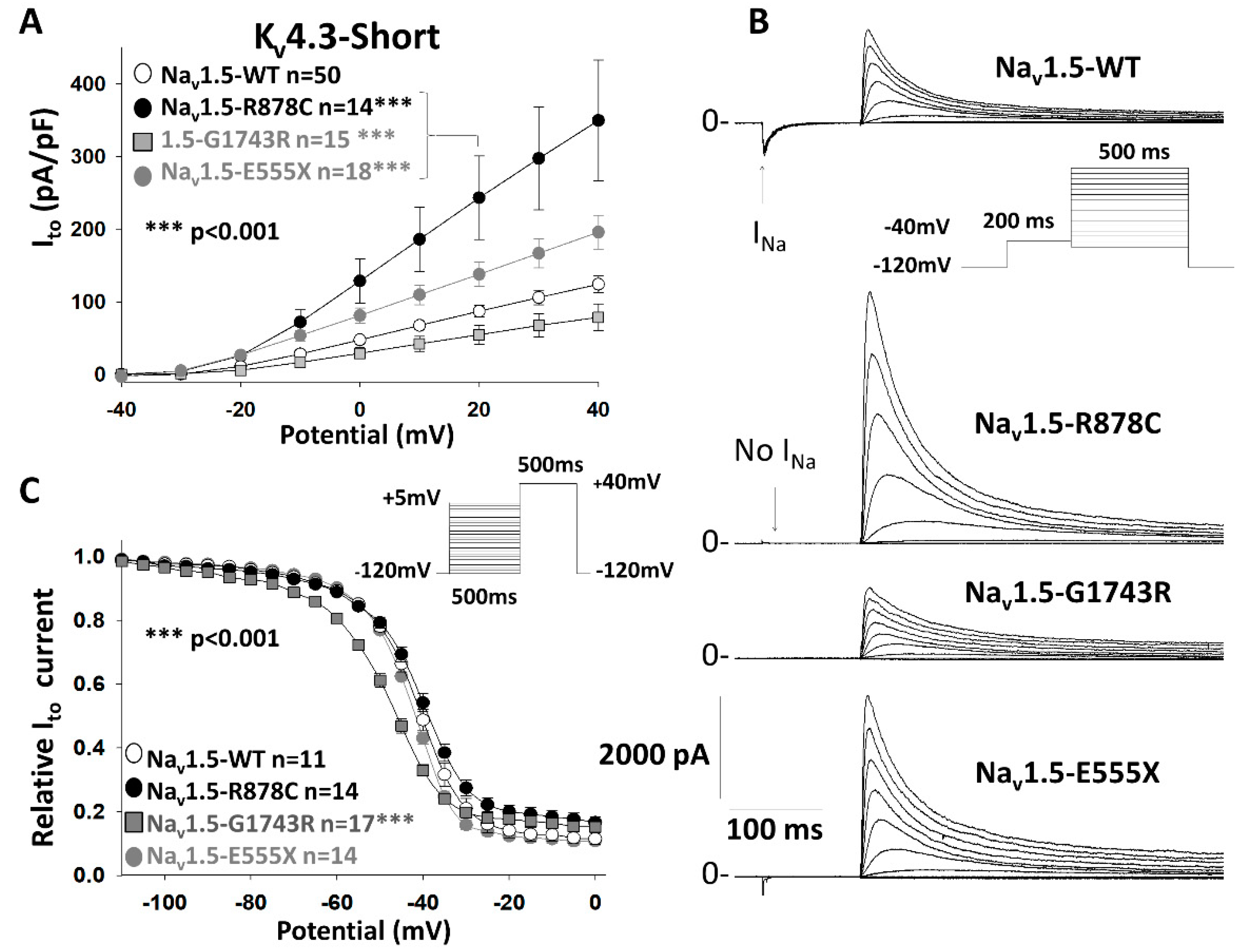
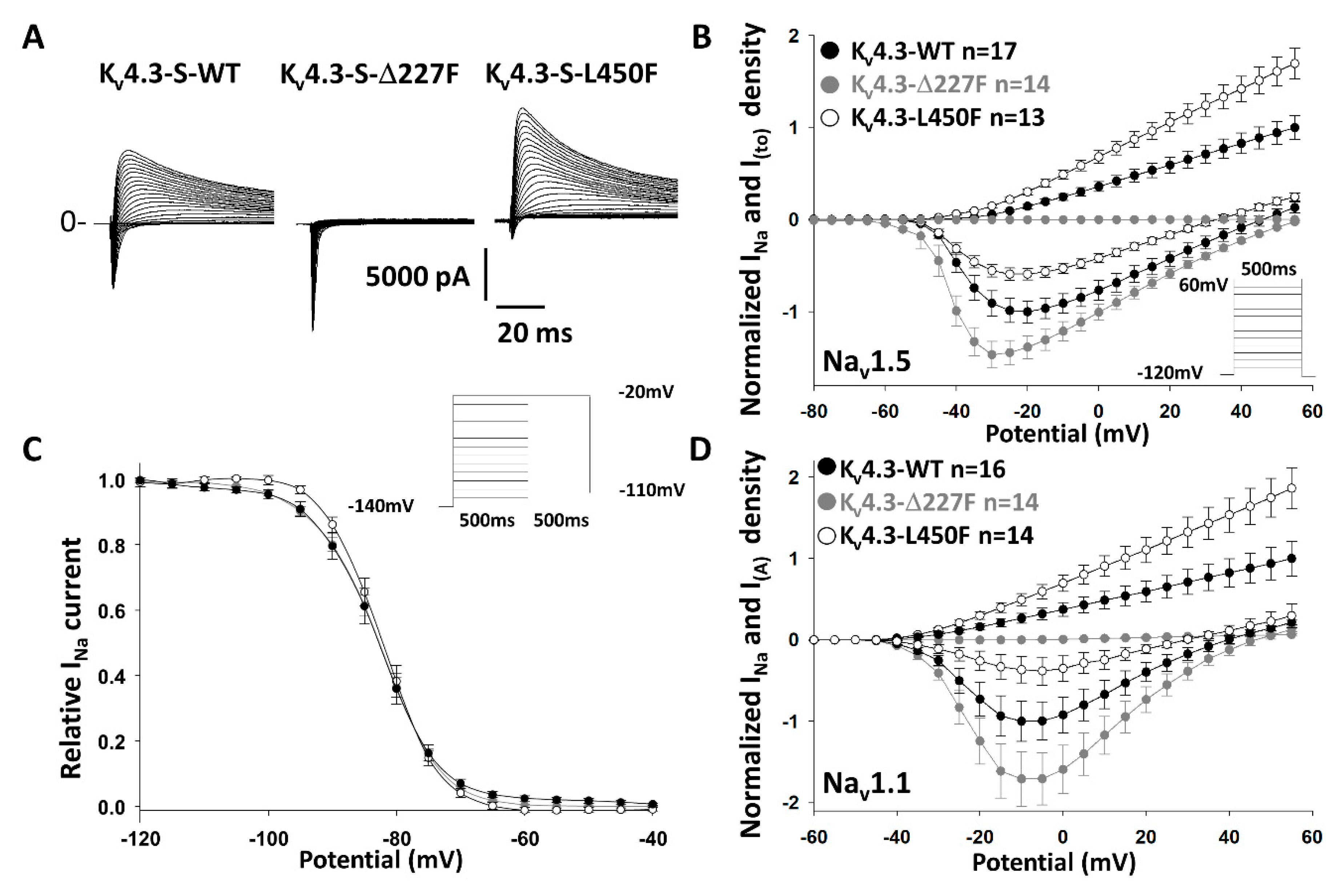
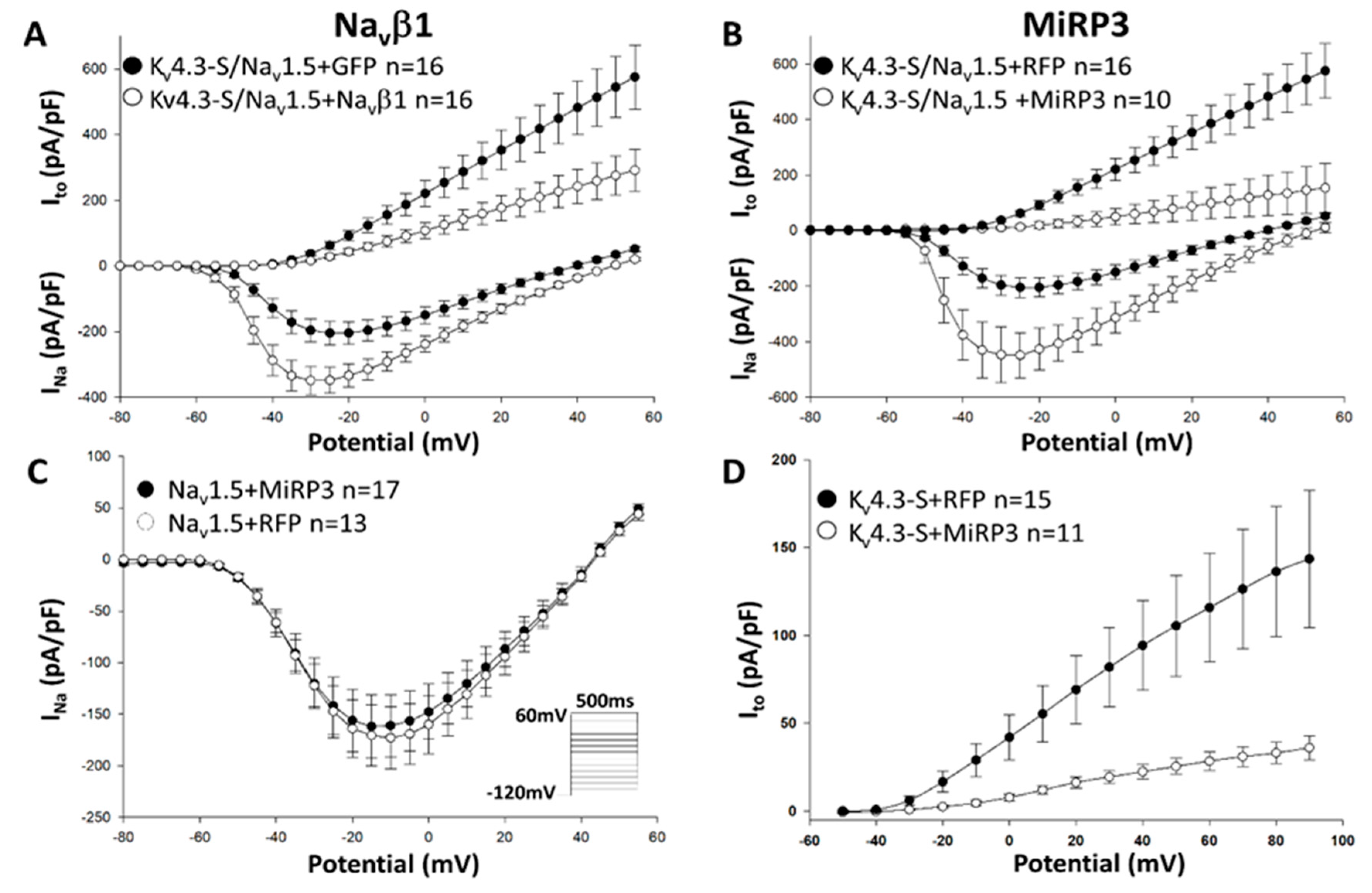
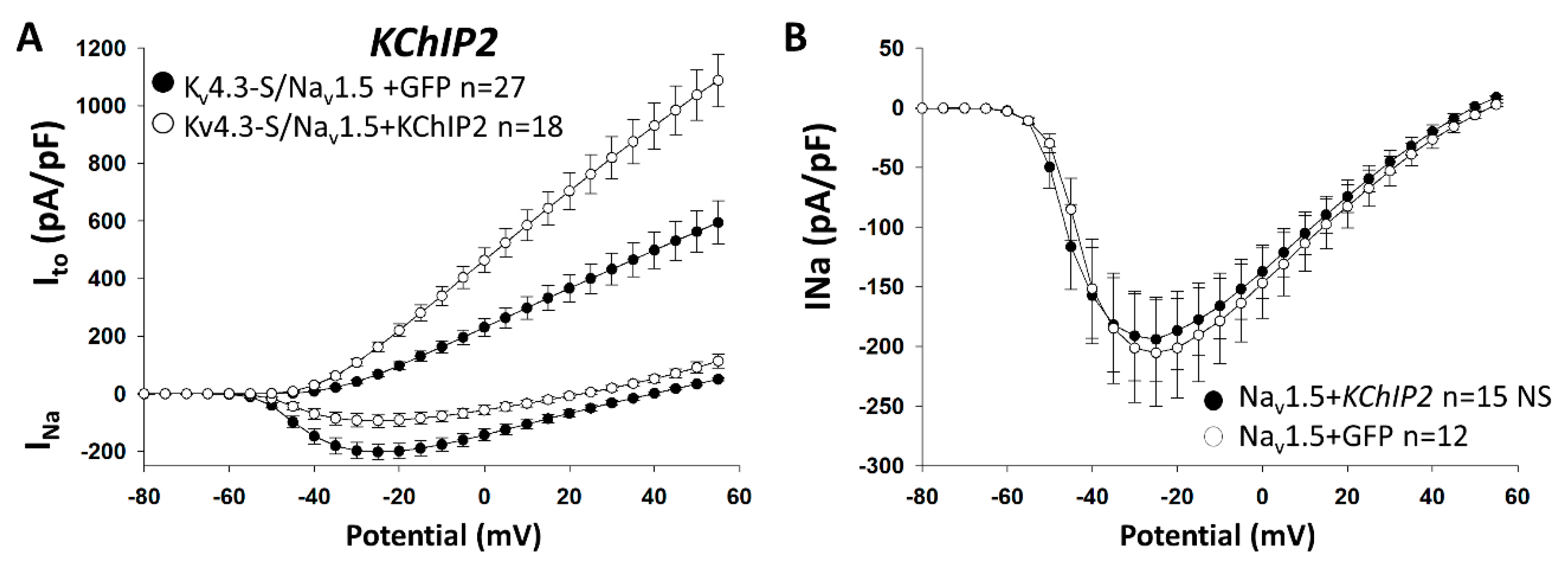
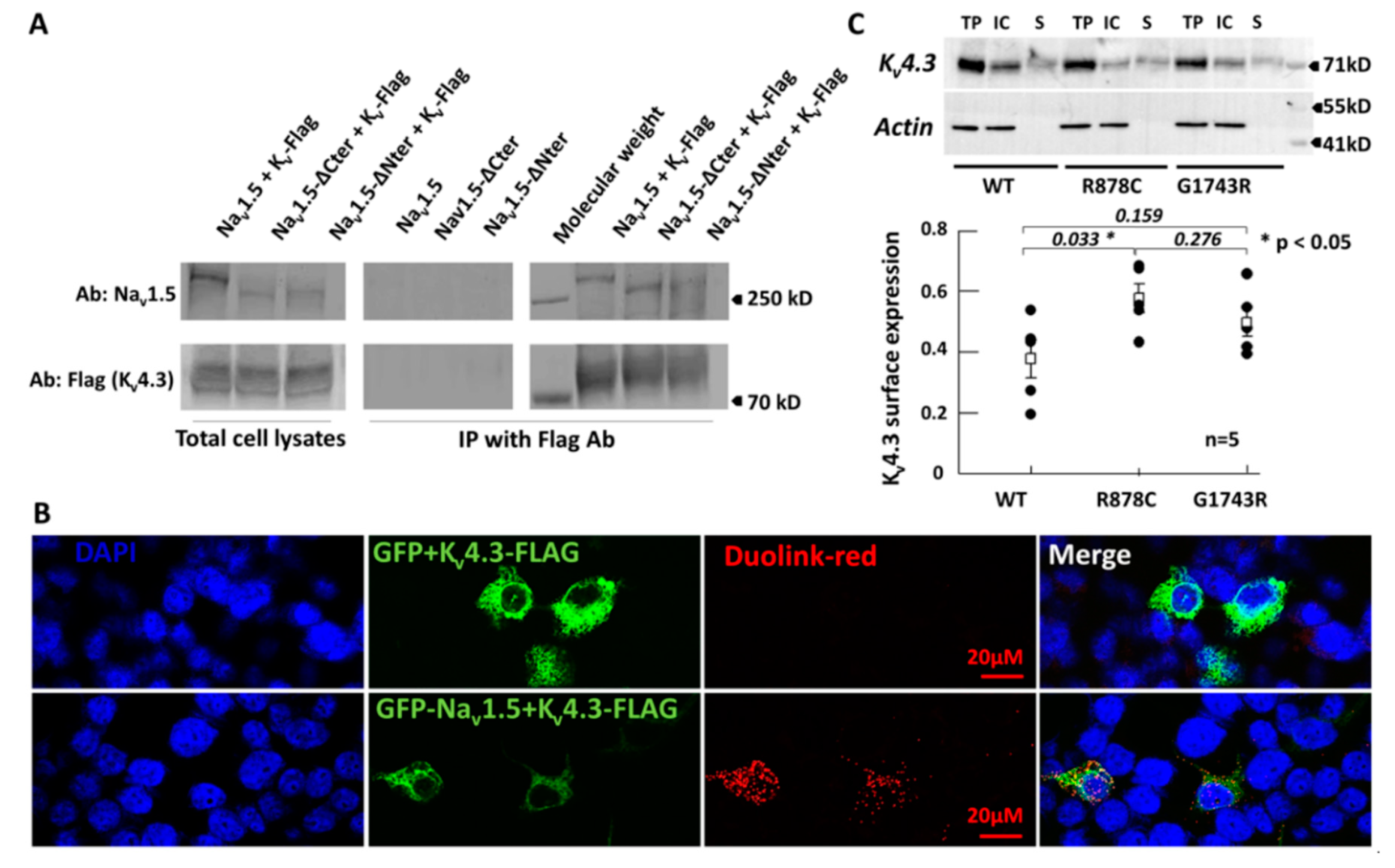
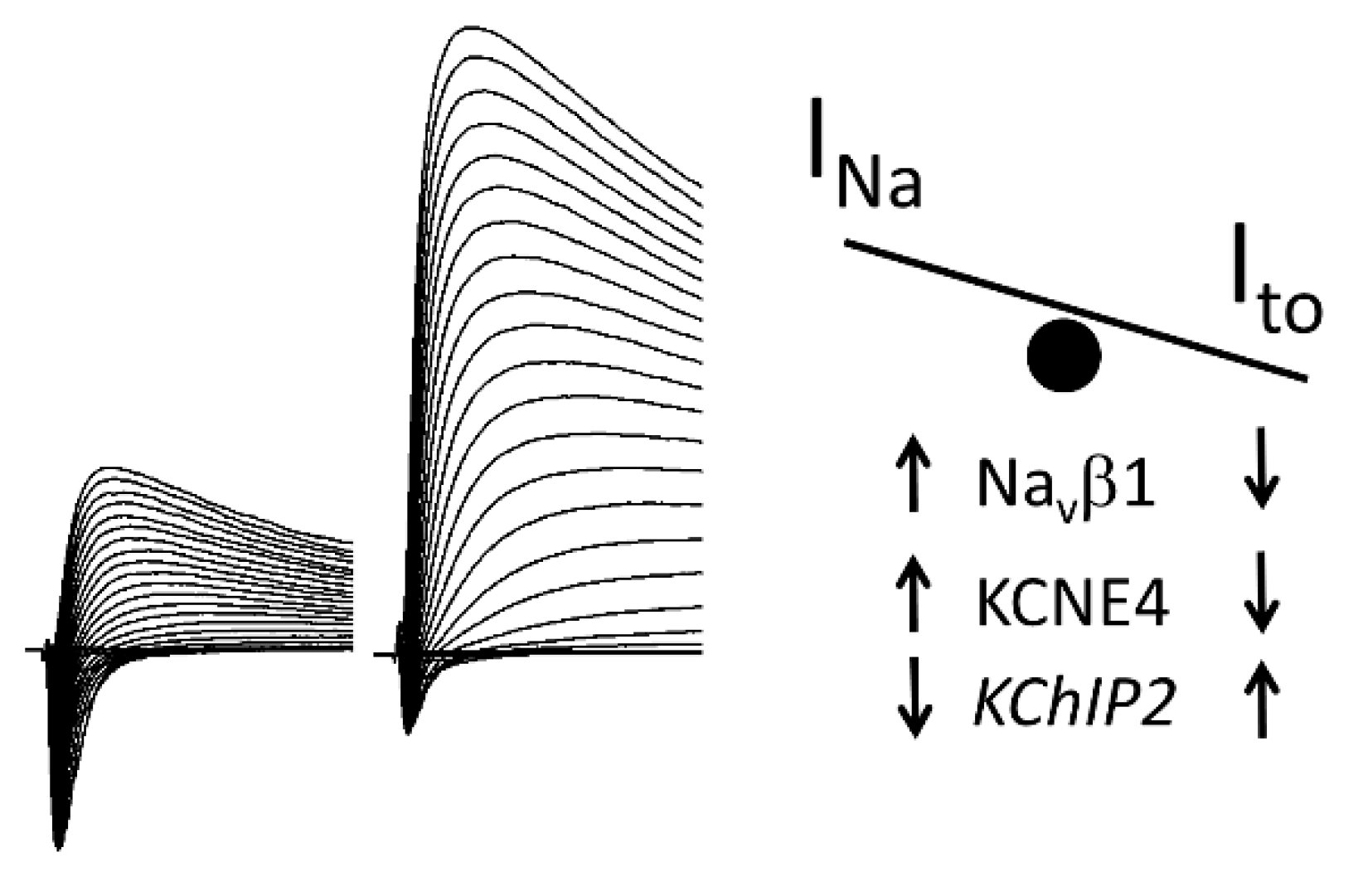
| Variant | n | Ito Peak +20 mV | SEM | Fold Change | p | n | V1/2 SSI Ito | SEM | Shift | p | Relative Ito, HP at −40 mV | SEM | Fold Change in Peak Ito, HP at −40 mV |
|---|---|---|---|---|---|---|---|---|---|---|---|---|---|
| WT | 50 | 87.1 | 8.2 | NA | NA | 11 | −40.03 | 0.93 | NA | NA | 48.7 | 0.03 | 1 |
| R878C | 14 | 243.3 | 57.6 | 2.79 | <0.001 | 14 | −39.74 | 1.2 | 0.29 | NS | 54.2 | 0.03 | 1.11 |
| E555X | 15 | 138.0 | 16.8 | 1.58 | <0.001 | 18 | −41.65 | 0.37 | −1.62 | NS | 43 | 0.02 | 0.88 |
| G1743R | 18 | 54.8 | 12.9 | 0.63 | <0.001 | 15 | −46.22 | 0.75 | −6.19 | <0.001 | 32.9 | 0.02 | 0.68 |
© 2020 by the authors. Licensee MDPI, Basel, Switzerland. This article is an open access article distributed under the terms and conditions of the Creative Commons Attribution (CC BY) license (http://creativecommons.org/licenses/by/4.0/).
Share and Cite
Clatot, J.; Neyroud, N.; Cox, R.; Souil, C.; Huang, J.; Guicheney, P.; Antzelevitch, C. Inter-Regulation of Kv4.3 and Voltage-Gated Sodium Channels Underlies Predisposition to Cardiac and Neuronal Channelopathies. Int. J. Mol. Sci. 2020, 21, 5057. https://doi.org/10.3390/ijms21145057
Clatot J, Neyroud N, Cox R, Souil C, Huang J, Guicheney P, Antzelevitch C. Inter-Regulation of Kv4.3 and Voltage-Gated Sodium Channels Underlies Predisposition to Cardiac and Neuronal Channelopathies. International Journal of Molecular Sciences. 2020; 21(14):5057. https://doi.org/10.3390/ijms21145057
Chicago/Turabian StyleClatot, Jérôme, Nathalie Neyroud, Robert Cox, Charlotte Souil, Jing Huang, Pascale Guicheney, and Charles Antzelevitch. 2020. "Inter-Regulation of Kv4.3 and Voltage-Gated Sodium Channels Underlies Predisposition to Cardiac and Neuronal Channelopathies" International Journal of Molecular Sciences 21, no. 14: 5057. https://doi.org/10.3390/ijms21145057
APA StyleClatot, J., Neyroud, N., Cox, R., Souil, C., Huang, J., Guicheney, P., & Antzelevitch, C. (2020). Inter-Regulation of Kv4.3 and Voltage-Gated Sodium Channels Underlies Predisposition to Cardiac and Neuronal Channelopathies. International Journal of Molecular Sciences, 21(14), 5057. https://doi.org/10.3390/ijms21145057







